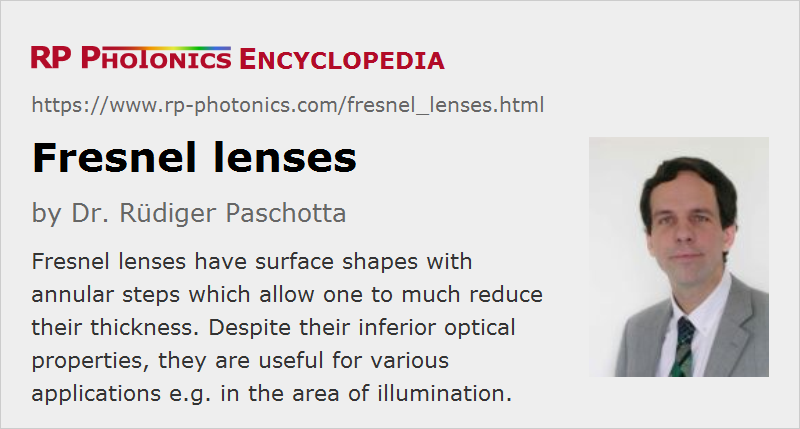Fresnel Lenses
Definition: lenses where the surface profile has annular steps
More general term: lenses
German: Fresnel-Linsen, Stufenlinsen
How to cite the article; suggest additional literature
Author: Dr. Rüdiger Paschotta
Fresnel lenses are a special kind of optical lenses, where the surface profile contains annular steps such that a given focal length can be achieved with a substantially reduced thickness of the lens. This reduction of thickness can be very useful when realizing lenses with very large diameters and substantial dioptric powers. The original application of the inventor, Augustin-Jean Fresnel, was for lighthouses, where the light generated by a high-power lamp had to be redirected with a reasonably compact optical setup. This operation principle is illustrated in Figure 1, showing two versions of lenses with the same focal length. The upper version has more annular steps and can therefore be made thinner.

Design Details
A first approach for designing such a lens may be simply to translate different annular sections of the surface in a parallel fashion, preserving their orientation. However, that approach would not lead to the same optical properties as the original thick lens. For better performance, the curvature of the outside parts should be adapted.
In general, one will use aspheric shapes (→ aspheric lenses); given that the surface shape can anyway not be spherical, there would be no reason for choosing spherical shapes for the annular sections, if another shape gives better optical performance. For lenses with small steps, it may be sufficient to use conic shapes, because this makes only a small difference, at least for non-imaging applications.
In the area of diffractive optics, one sometimes uses similar looking designs of microlenses, where the steps are dimensioned such that they correspond to optical phase changes which are integer multiples of 2 π. For Fresnel lenses, however, this principle is usually not used; they are purely refractive devices, not utilizing diffraction. It would actually be difficult to implement it for large lenses with the required precision. The contributions of different radial statements to an image are therefore generally considered as mutually incoherent, and the limitation of resolution by diffraction is related to the segment size rather than to the whole diameter of the lens, but diffraction-limited performances anyway often not reached. One may at least adjust the slopes of the steps such that the resulting disturbances for the light field are minimized.
There are also cylindrical Fresnel lenses, where the curvature and the steps are only in one direction. Some devices are not even used for focusing (and may thus not be called lenses), but only for deflecting beams or images.
Fabrication
Different fabrication techniques can be used for Fresnel lenses. For example, plastic lenses can be made with molding or embossing processes. Glass lenses can be fabricated with computer-controlled milling. Usually, Fresnel lenses are made as a single piece of material.
Optical Performance
Compared with an ordinary lens with a smooth surface shape, a Fresnel lens usually has substantially inferior optical properties; the steps cause some loss of light and scattering in unwanted directions. For the typical applications, however, such imperfections can be tolerated, while the advantage of a much reduced thickness and accordingly reduced weight can be beneficial or even essential.
Typical Applications of Fresnel Lenses
Fresnel lenses are mostly used in the area of illumination, where non-ideal optical performance can be easily tolerated. For example, for the original application in lighthouses it was no problem that some of the light was not ideally directed. Fresnel lenses are widely used as condensers in overhead projectors, where the small thickness is of essential importance, but there is a number of other application areas such as projection TVs, traffic lights and concentrating solar power.
There are also imaging applications, for example lightweight hand-held magnifier lenses and even photography with compact cameras.
Suppliers
The RP Photonics Buyer's Guide contains 12 suppliers for Fresnel lenses. Among them:

Shanghai Optics
Shanghai Optics can produce a large number of high-performance lighting lenses, including lighting aspheric lenses, Fresnel lenses, spherical lenses, flat pieces, prisms and other products. Main applications are automobile lights, airport runway lights, projection lighting, LED lighting, etc.
Questions and Comments from Users
Here you can submit questions and comments. As far as they get accepted by the author, they will appear above this paragraph together with the author’s answer. The author will decide on acceptance based on certain criteria. Essentially, the issue must be of sufficiently broad interest.
Please do not enter personal data here; we would otherwise delete it soon. (See also our privacy declaration.) If you wish to receive personal feedback or consultancy from the author, please contact him e.g. via e-mail.
By submitting the information, you give your consent to the potential publication of your inputs on our website according to our rules. (If you later retract your consent, we will delete those inputs.) As your inputs are first reviewed by the author, they may be published with some delay.
See also: lenses, condensers
and other articles in the category general optics
 |






If you like this page, please share the link with your friends and colleagues, e.g. via social media:
These sharing buttons are implemented in a privacy-friendly way!